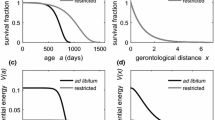Abstract
The bit-string model of biological aging introduced by Penna is investigated. This is a well-established model, making use of mutation accumulation theory. However, it turns out that a correct use of the Verhulst factor is not made and therefore in a certain limiting case the model does not produce proper results. Furthermore, care has to be taken when chosing the time steps in the model to avoid unrealistic effects.
Similar content being viewed by others
REFERENCES
A. T. Bernardes, J. Phys. I France 5:1501 (1995).
B. Charlesworth, Evolution in Age-Structured Populations (Cambridge Univ. Press, Cambridge, 1980).
L. Partridge and N. H. Barton, Nature 362:305 (1993).
T. J. P. Penna, J. Stat. Phys. 78:1629 (1995).
T. J. P. Penna and S. M. de Oliveira, J. Phys. I France 5:1697 (1995).
T. J. P. Penna, S. M. de Oliveira, and D. Stauffer, Phys. Rev. E 52:3309 (1995).
M. R. Rose, Evolution Biology of Aging (Oxford Univ. Press, Oxford, 1991).
D. Stauffer, Braz. J. Phys. 24:900 (1994).
D. Stauffer, Physik in unserer Zeit 4:175 (1996).
F. Verhulst, Nonlinear Differential Equations and Dynamical Systems (Springer-Verlag, Berlin, 1990).
Author information
Authors and Affiliations
Rights and permissions
About this article
Cite this article
Raab, A. Comment on “A Bit-String Model for Biological Aging”. Journal of Statistical Physics 91, 1055–1060 (1998). https://doi.org/10.1023/A:1023040202377
Issue Date:
DOI: https://doi.org/10.1023/A:1023040202377



